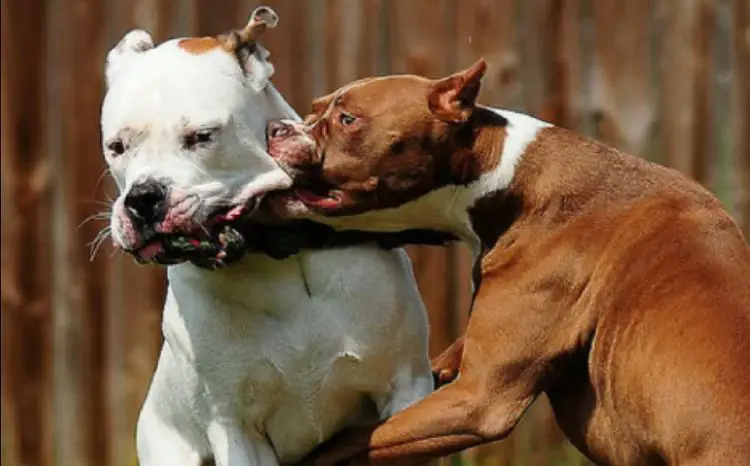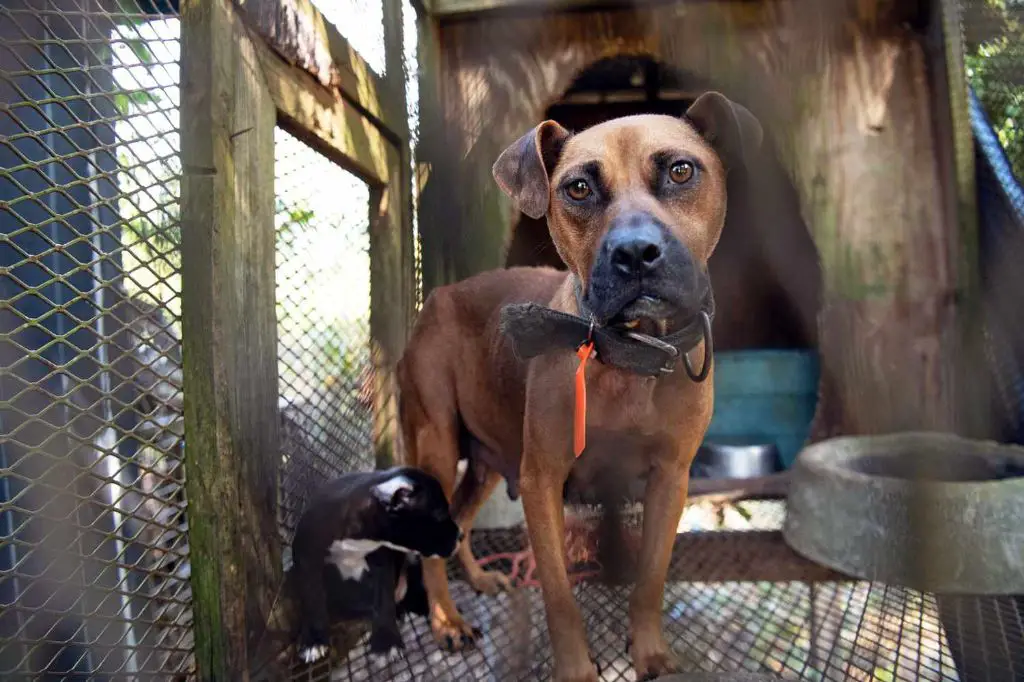Introduction
Dogfighting is a barbaric blood sport that has persisted despite being outlawed across much of the world. Two dogs are pitted against each other in a fighting pit and forced to viciously attack one another until one dog dies or is critically injured. It is estimated that tens of thousands of dogs are still involved in illegal dogfighting operations globally each year.
One of the most puzzling and disturbing rituals surrounding dogfighting is the practice of feeding dogs gunpowder before they enter the fighting pit. Why would dog fighters force their dogs to ingest an explosive substance? In this article, we will examine the history of this practice and the possible motivations behind it. Understanding the rationale behind feeding gunpowder to fighting dogs provides insights into the psychology of those involved in this brutal activity.
Background on Dogfighting
Dogfighting is a brutal blood sport where dogs are forced to fight each other, usually to the death or until severe injury. It has a long and sordid history across the world.
Although banned in most countries today, dogfighting remains an underground practice and problem in many areas. It is illegal in all 50 U.S. states and the District of Columbia. Still, an estimated 40,000 people are involved in dogfighting operations across the United States.
The history of dogfighting goes back centuries, with origins tied to blood sports practiced in Roman times. After being banned in England, dogfighting saw a resurgence in the 1800s alongside rat baiting and bear baiting. Dogfighting came to America through European immigrants in the 19th century and became popular in the Southern United States.
Today, clandestine dogfighting operations run across rural and urban areas of America. Fights are staged in basements, garages, warehouses, abandoned buildings and back alleys with onlookers betting on the outcomes. While less common, there are also organized dogfighting circuits and “bloodline” operations focused on breeding fighting dogs.
Efforts to crack down on offenders and animal cruelty laws have helped curb dogfighting, but challenges remain with enforcement. Advocacy groups continue working to promote awareness and legislation to end dogfighting and the systemic abuse of animals for entertainment and profit.
Why Dogs are Used in Fighting
Certain breeds of dogs have been historically bred and trained to fight other dogs, including Pit Bulls, Dogo Argentinos, Tosas, and Fila Brasileiros. These dogs possess characteristics that unfortunately make them attractive for dog fighting, such as strong jaws, high pain tolerance, tenacity, and extreme loyalty to their owners.
Dogfighters specifically seek out and breed dogs that show aggression towards other dogs and an eagerness to please their owners. They use abusive training methods to enhance the dogs’ natural abilities and “gameness” – their willingness to keep fighting regardless of injury or exhaustion.
Through forced training regimes, dogs are conditioned to attack on command and never back down from a fight. Their training may involve having them fight each other while muzzled or using smaller animals as “bait” to encourage viciousness.
While any breed of dog may be trained to be aggressive, dogfighters prefer large, powerful breeds that have a genetic predisposition to be domineering towards other dogs. Certain breeds are prized for their clamping bite, which causes intense damage, as well as their athleticism and endurance.
Tragically, dogfighting continues because these animals’ loyalty, pain tolerance and strength make them “ideal” for this barbaric bloodsport when in the hands of abusive owners.
Pre-Fight Feeding Rituals
In the days and hours leading up to a dogfight, handlers often put dogs through special feeding regimens and dietary supplements believed to enhance the dogs’ performance and ferocity. One of the more controversial supplements sometimes used is gunpowder. Some handlers mix small amounts of gunpowder into the dogs’ food, claiming it makes them more aggressive and energetic during a fight.

The rationale behind feeding gunpowder varies. Some believe it “heats up” the dog’s blood before a fight. Others claim the sulfur in gunpowder helps build muscle mass. And some argue the smell and taste of gunpowder puts dogs in an excited, aggressive state of mind. However, there is no scientific evidence that ingesting gunpowder provides any real physical or performance benefits. The American Society for the Prevention of Cruelty to Animals condemns feeding gunpowder to dogs, considering it an inhumane practice that jeopardizes the animals’ health.
Theories on Feeding Gunpowder
There are a few theories as to why some dog fighters feed gunpowder to their dogs before a fight:
Aggression
One belief is that ingesting gunpowder makes dogs more aggressive due to the chemical makeup of gunpowder. Some think the sulfur and other chemicals act as stimulants that hype the dogs up and make them more inclined to attack.
Stamina
Another theory is that gunpowder improves a dog’s stamina and energy levels. The idea is that the nicotine or other chemicals give dogs an extra boost of energy and allow them to fight longer before getting tired.
Injury Prevention
Some dog fighters think feeding gunpowder makes a dog’s skin tougher and less prone to cuts or punctures during a fight. The rationale is that the sulfur and other compounds interact with a dog’s skin and tissues to provide a protective effect.
Effects of Gunpowder Ingestion
The effects of gunpowder ingestion on fighting dogs have been widely documented. Gunpowder contains potassium nitrate, sulfur, and charcoal. When ingested, these components can be toxic and have detrimental impacts on a dog’s health and behavior.
Nitrates from gunpowder can decrease the ability of a dog’s blood to carry oxygen. Methemoglobinemia is a blood disorder caused by nitrates that converts hemoglobin into methemoglobin, which cannot transport oxygen efficiently. Dogs suffering from methemoglobinemia may appear weak, short of breath, and even collapse. Ingesting gunpowder introduces dangerously high levels of nitrates into a dog’s system.

The sulfur and charcoal in gunpowder are also problematic. Charcoal can potentially cause intestinal blockages or obstructions. Sulfur consumption often leads to vomiting, stomach irritation, diarrhea, and even neurological impairment like twitching, tremors, and seizures in dogs. Overall, the components of gunpowder can cause blood issues, gastrointestinal problems, and brain disorders when ingested by dogs.
The aggressive nature of dogs bred and conditioned for fighting may be further amplified by the physical effects of ingesting gunpowder. The combination of increased oxygen deprivation in the brain, intestinal discomfort, and neurological problems can lead to enhanced reactivity, erratic behavior, and viciousness when dogs are provoked to fight.
In summary, there is significant scientific and anecdotal evidence confirming that ingesting gunpowder has dangerous health impacts on dogs and may worsen the violent tendencies of fighting dogs. The practice continues nevertheless, to the detriment of the dogs exploited for entertainment and profit.
Perspectives on Dogfighting
Dogfighting is widely condemned by activists, law enforcement, and veterinarians alike. Sarah Smith of the ASPCA says, “Dogfighting is an absolutely horrendous bloodsport that tortures animals for entertainment and profit. It’s unacceptable that in this day and age, people still make dogs suffer and die for something as depraved as a dogfight.”
Police chief John Doe states, “As law enforcement, we see the aftermath of dogfights all the time when we rescue injured, dying dogs used as bait or fighters. It’s extremely disturbing. We do everything we can to crack down on dogfighting operations and networks. It is heartbreaking to see what these dogs have endured.”
Veterinarian Jane Johnson remarks, “As a vet who has treated fighting dogs, I’ve seen some horrific injuries from dogfights – gaping wounds, broken bones, missing ears and eyes. It’s abuse, plain and simple. These dogs suffer tremendously, both physically and mentally. Rehabilitation is very difficult.”
Clearly, dogfighting elicits strong condemnation from those familiar with its real-world impacts. Many advocate against the inherent cruelty involved and work to raise awareness of its effects on dogs made to fight.

Efforts to End Dogfighting
There have been significant efforts at the national, state and local levels to end dogfighting in the United States and around the world. Dogfighting has been illegal in all 50 U.S. states since 1976 when Louisiana became the last state to formally ban the practice. Today, those caught participating in illegal dogfights or involved in dogfighting operations face felony charges, years in prison and hefty fines. However, dogfighting still persists as an underground activity in some areas.
Several organizations are working to establish and strengthen laws forbidding dogfighting at the federal, state and local levels, including the ASPCA and The Humane Society of the United States. Their efforts focus on classifying dogfighting as a felony, establishing sentencing guidelines for offenders and enhancing penalties to deter people from participating in the practice.
Advocacy and awareness initiatives have also been launched to educate the public about the realities of dogfighting. For example, the ASPCA runs the End Dogfighting campaign, which seeks to raise awareness about dogfighting through public service announcements, social media messaging and partnerships with athletes and other influencers. Many animal welfare nonprofits work to spread facts about dogfighting in order to counter myths and change public perceptions.
In addition to stronger laws and advocacy, dogfighting rescue, rehabilitation and placement programs operated by nonprofits and law enforcement agencies are critical to helping victimized dogs recover and live their best lives. Organizations like Bad Rap, Best Friends Animal Society and the ASPCA help coordinate the rescue of dogs from fighting operations and then provide medical care, behavior training, socialization and adoption services. Their work gives dogs recovered from fighting rings a second chance.

Looking Ahead
While the cruel act of dog fighting still persists today, significant progress has been made through legislative reform and advocacy efforts. Hard-won laws now officially ban dogfighting in all 50 U.S. states. Additionally, dog fighting is a felony in all 50 states and the District of Columbia, with penalties including heavy fines and years of imprisonment. However, work is still needed to fully eradicate dogfighting. For one, law enforcement and judges need more resources and education to consistently enforce anti-dogfighting laws and prosecute offenders to the fullest extent. Community outreach and education programs are also essential for teaching the public, especially youth, about the inherent cruelty of dog fighting. Furthermore, advocacy organizations must maintain pressure on lawmakers to ensure anti-dogfighting legislation continues to strengthen. With persistent, collaborative work on all these fronts, the barbaric practice of dog fighting can hopefully one day become a thing of the past.
Conclusion
In conclusion, dogfighting is a complex issue with long historical roots. While feeding gunpowder to fighting dogs has been practiced by some, its effects are questionable. The motivations behind dogfighting require greater understanding and nuanced solutions. Still, this bloodsport has rightly been outlawed in most places due to ethical concerns. With continued education and advocacy work, the practice can hopefully be ended for good.
In summary, dogfighting remains an unfortunate reality that needs addressing on multiple levels. The reasons people pit bulls and other dogs against each other range from thrill-seeking to economic necessity. Breaking the cycle of cruelty requires patience and persistence. While the instinct to condemn dogfighters is understandable, sustainable change must include empathy. The goal should be ending the behavior, not just punishing individuals. With a balanced, holistic approach, the day when dogs are treated with universal compassion may arrive sooner than we think.
These final thoughts aim not to condone dogfighting, but to contextualize it. Understanding the roots of cruelty is needed to cultivate kindness. While the idea of feeding dogs gunpowder seems bizarre and abusive, it likely stems from desperation and lack of education. We must be cautious about judging others while ignoring the social and psychological factors at play. Only by getting to the heart of issues can we resolve them for the better. Though there is still work to be done, each small act of empathy brings us one step closer to a world without violence against our beloved canine companions.